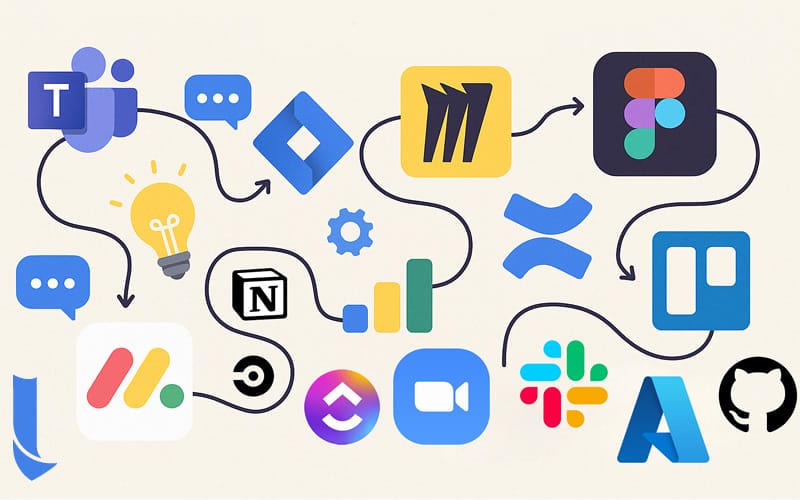Collaborative Tools as Drivers of Agile Team Performance

Agility is built on core values: collaboration, responsiveness, transparency, and continuous improvement. For agile teams, using collaborative tools is a key performance driver. Whether for planning, communication, or tracking progress, each tool helps solve a specific challenge while staying true to agile principles. Here’s an overview of tools grouped by theme, highlighting the problems they address and how they align with agile practices.
Planning and Project Management: Structure without Rigidity
Tools: Jira, Trello, ClickUp, Azure DevOps, Monday.com
Problem addressed: Balancing task organization with the need for flexibility.
Agile benefit: These tools visualize backlogs, sprints, user stories, and tasks using Kanban or Scrum boards. They promote transparency and prioritization—key elements in agile. For example, Jira links business goals to technical tasks while tracking team velocity.
Agile alignment: By supporting iterative planning and regular inspection, these tools enable frequent delivery and quick feedback cycles.
Communication and Synchronization: Breaking Down Silos
Tools: Slack, Microsoft Teams, Discord, Zoom, Google Meet
Problem addressed: Loss of information and lack of daily coordination.
Agile benefit: These platforms support real-time and asynchronous communication. Integrations with other tools (Jira, GitHub, Confluence…) centralize information and reduce interruptions. Slack, for example, is great for daily stand-ups and dedicated team channels.
Agile alignment: Agile encourages frequent, face-to-face (or virtual) communication. These tools help recreate a collaborative environment—even in remote or hybrid settings.
Knowledge Sharing and Documentation: Capturing Insights Without Bureaucracy
Tools: Confluence, Notion, Google Docs, Miro, Coda
Problem addressed: Lack of traceability or shared knowledge in fast-paced environments.
Agile benefit: These tools document decisions, specs, and retrospectives. Miro supports visual collaboration and ideation workshops. Notion offers flexibility to build lightweight documentation systems.
Agile alignment: Agile values “just enough” documentation. These platforms allow teams to create living documents that evolve with the product.
Code Management and Continuous Integration: Ensuring Quality at Speed
Tools: GitHub, GitLab, Bitbucket, Jenkins, CircleCI
Problem addressed: Maintaining code quality while delivering quickly.
Agile benefit: These tools support version control, code reviews, and automated CI/CD pipelines. They enable fast, reliable deployments. GitLab, for instance, combines DevOps features with agile project tracking.
Agile alignment: They reinforce the agile goal of continuous delivery, automated testing, and rapid feedback loops.
Feedback and Continuous Improvement: Adapting Constantly
Tools: FunRetro, Parabol, TeamRetro, EasyRetro
Problem addressed: Unstructured or inconsistent retrospective processes.
Agile benefit: These platforms guide remote retrospectives, structure discussions, and track actions. TeamRetro offers various formats (Start/Stop/Continue, Mad/Sad/Glad…) to enhance reflection and engagement.
Agile alignment: Continuous improvement is a core agile pillar. These tools make it easier to inspect and adapt processes in a consistent way.
Conclusion
Agility is not just a methodology—it’s a mindset. Collaborative tools aren’t the goal; they’re enablers of an agile culture. When thoughtfully selected and well-integrated, these tools streamline processes, foster engagement, and empower teams to deliver value faster and more meaningfully. For every phase of the agile cycle, there are tools that can help—what matters is choosing them wisely, without adding rigidity to agile practices.
